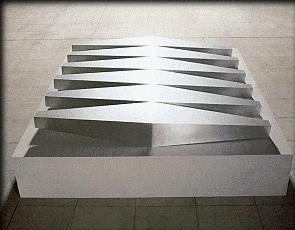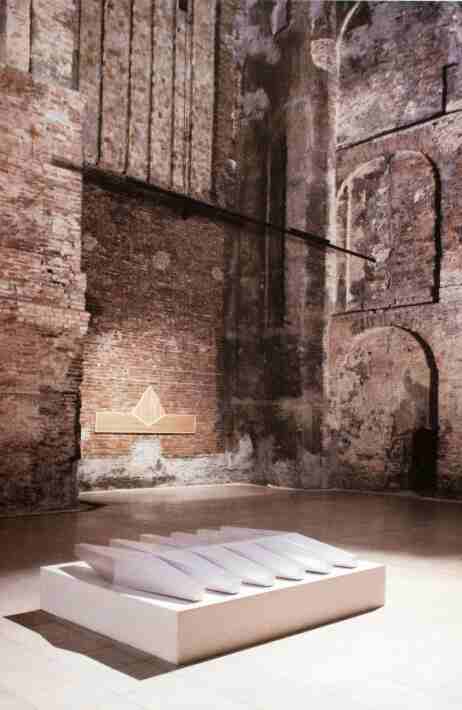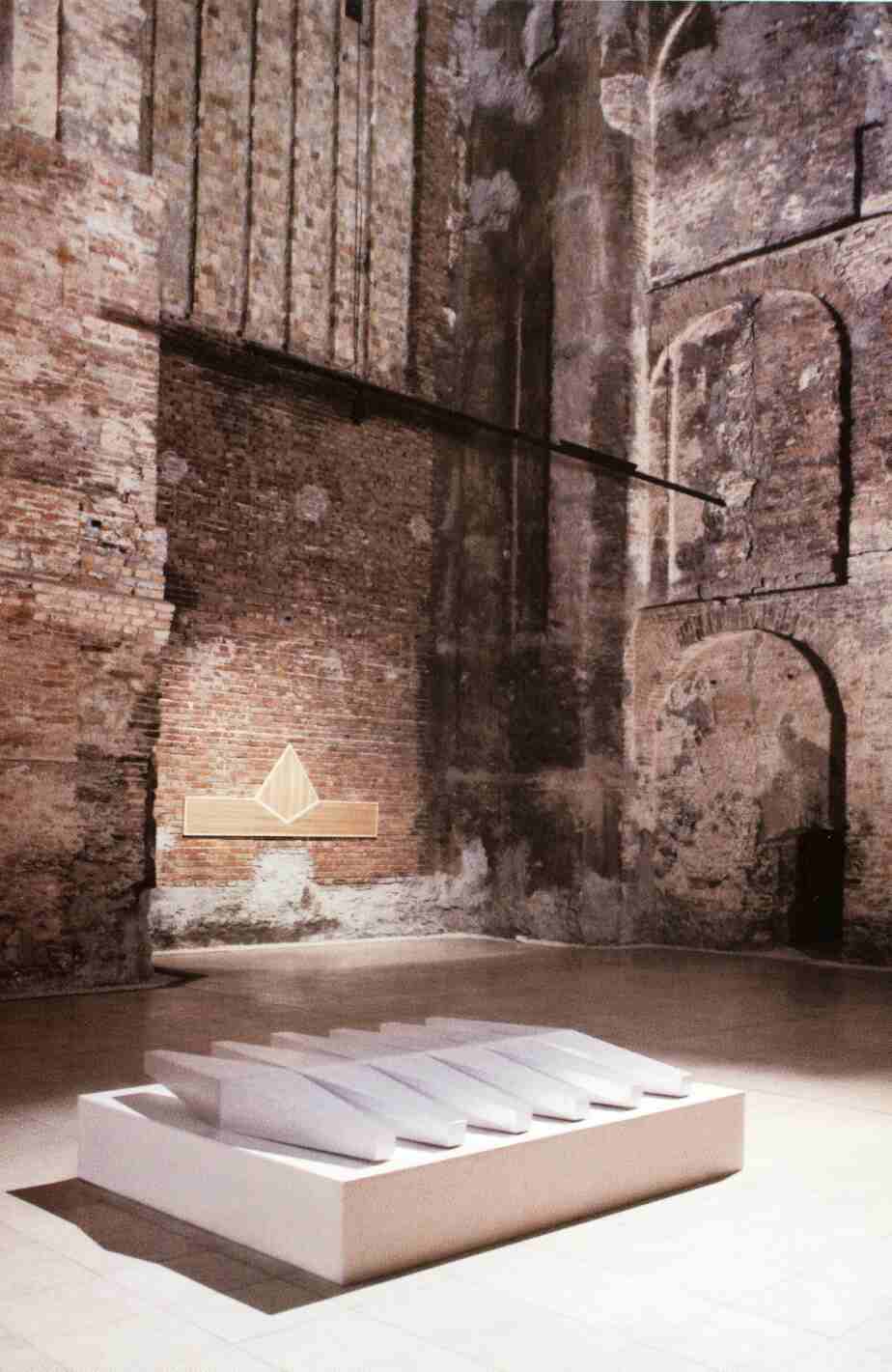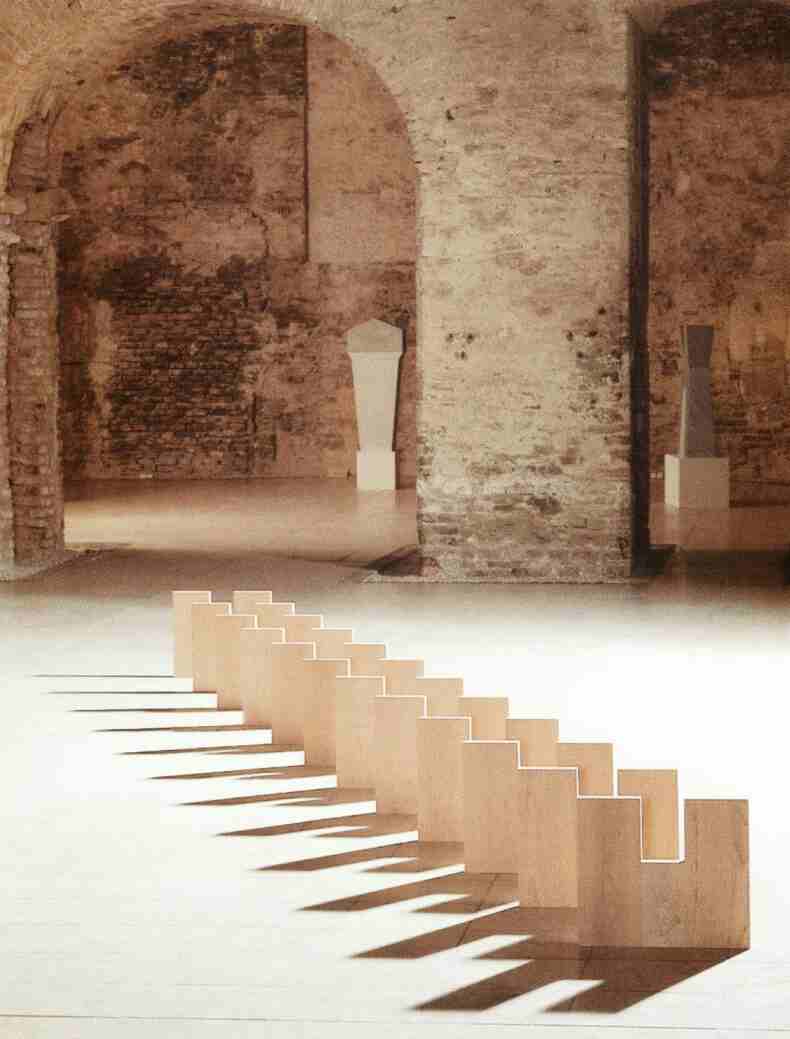A New York Sculptress: Carol Ross
The art of nations with a rational frame of mind somehow tends
more towards the mystical, romantic and surrealistic approach whereas peoples
with greater romantic propensities are more easily inclined to adopting
a colder, a more structuralist and constructive approach to their art.
The latter tendency is powerfully present in twentieth century Hungarian
art via Kassák and Moholy-Nagy tradition. On the other hand, Hungarian
surrealism is, almost non-existent. Geometric construction and puritan
rationalism does not only surface in the second decade of this century,
but accompanies it throughout, almost to this day in painting and sculpture
alike.

The Hungarian public will probably feel closely to the art of Carol
Ross. After all, this kind of puritan minimalist geometry is cultivated
by many in this land and this type of art of engineer-style simplicity
and working with geometrical forms has always also looked back on formidable
tradition in Hungary. The New York sculptress has come a very long way,
starting out as a painter in the Sixties with pictures that linked up large
and colourful forms. And not without considerable acclaim whereby she became
rather widely known. Then a certain point she decided to give up painting
and chose working with freely fashioned colourful forms in sculpture as
her next artistic terrain.
 Carol
Ross's metal statues are dimensional while her wooden reliefs hardly ever
leave the plane. Metal and wood, exquisite carpentry, excellent unpolished
aluminium, elegantly polished homogeneous surfaces which nonetheless have
texture: they are "cat hair" surfaces. Rigid straight lines of a dull lustre,
at the same time soft arches connect. Shadowy surfaces turn to black. The
cross-impact of triangles create sham dimensions, planes bending inside
and out, with almost distorted spaces emerging while lines remain perceptibly
straight. New York roof tops are crowded with a myriad of wondrous oddities:
water tanks, chimneys, iron steps and traverses in chaotic disarray. There
is a green chimney on the roof top opposite the studio window shaped exactly
a basic element, a building block of one of the "Columns". "Mummy" is really
a tombstone, the "most European" item being "3 Triangles", which is geometric
almost in the Bauhaus vein. The two large wooden pictures ("High Arch"
and "Split Arch evoke the form of Nádler's Sixties petal and Avar
motifs in the Hungarian onlooker. The seven-fold division of layered sheet-plate
by way of a contra-contour (light and not dark) shapes almost vegetative
forms, creating soft, gothic-style arches. The tulip forms is confined
into an internal geometric quadrangular plane.
Carol
Ross's metal statues are dimensional while her wooden reliefs hardly ever
leave the plane. Metal and wood, exquisite carpentry, excellent unpolished
aluminium, elegantly polished homogeneous surfaces which nonetheless have
texture: they are "cat hair" surfaces. Rigid straight lines of a dull lustre,
at the same time soft arches connect. Shadowy surfaces turn to black. The
cross-impact of triangles create sham dimensions, planes bending inside
and out, with almost distorted spaces emerging while lines remain perceptibly
straight. New York roof tops are crowded with a myriad of wondrous oddities:
water tanks, chimneys, iron steps and traverses in chaotic disarray. There
is a green chimney on the roof top opposite the studio window shaped exactly
a basic element, a building block of one of the "Columns". "Mummy" is really
a tombstone, the "most European" item being "3 Triangles", which is geometric
almost in the Bauhaus vein. The two large wooden pictures ("High Arch"
and "Split Arch evoke the form of Nádler's Sixties petal and Avar
motifs in the Hungarian onlooker. The seven-fold division of layered sheet-plate
by way of a contra-contour (light and not dark) shapes almost vegetative
forms, creating soft, gothic-style arches. The tulip forms is confined
into an internal geometric quadrangular plane. 
The twelve-part "Sitelines" is the veritable skeleton of a primeval
being - a backbone - writes along the ground in a beautiful cherry wood
colour. This rib impression is also repeated in the "Fuselage" series.
It is like a gigantic row of fish bones and, on the other hand, a polished
precious stone the two sides of which break light in distinctly different
ways. An Ornamental Comb. Returning to "Sitelines", this is a kind of row
of dominoes, an unfamiliar bulwark form on which shadows (of the previous
element) are far more geometrical than the wood form or are at least colder.
The wood is warm. These quadrangular shadows always fall someplace else
than where the line of dominoes is meandering. Their shape is slightly
reminiscent of Tamás Trombitás's mystical letters. "Owl"
is exactly like the ideal Bauhaus litter bin. It is discrete and perfect.
The "Arch with reaching roof" is the sole masculine, pant-clad piece. Its
remotest opposite is "Nested Lozenge") which is indubitably an ironing
board. And "Narrow Wing" reminded me of the old Ikarus emblem, which is
no real coincidence since that, too, was a wing. In this case it is a contra-contour
fashioned out of a sevenfold layered sheet-plate.
The four metal-surface statues ("Owl", "Mummy", "3 Triangles",
"Arch with reaching roof ") are put together from building elements in
the same vein as "3 Columns". They are quasi-variable because I do not
believe that they could also be assembled in any other way then they actually
are.
The big "wooden pictures" boast extremely exciting, almost picturesque
surfaces, particularly finely fitted cherry wood plywood surfaces with
the vein network of wood running vertically down the middle and horizontally
("High Arch") on the two wings. The same motif is even sophisticated in
the case of the two long, V-shaped petals, thereby creating a kind of monumental
inlay. 
The aforementioned cat hair pattern in the case of statues with
aluminium surfaces is distinctly recognizable only with "Columns" where
the pattern follows the vertical form. And in the case of "Fuselage" it
flows lengthways. The surface of the rest of the aluminium statues is homogeneous.
Eleanor Heartney wrote in the Carol Ross catalogue entitled "Wooden Constructions"
that in Ross's case there is no distinct difference between sculpture,
painting as she does with the network of veins in wood. This rather apt
perception also to some extent holds true for works in aluminium casing.
"3 Triangle" comprises two silver-coloured triangles pitched
face-to-face - a rombus - with a golden coloured aluminium roof -top is
the most European of Ross's works. If I were to consistently follow through
on the Hungarian analogising, then Gyula Gulyás would turn out to
be the most topical example to come to mind.
The sculpture of Carol Ross is a successful bid to create perfection
in an attempt to aspire towards pure geometry.